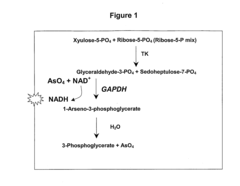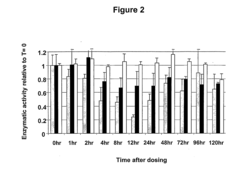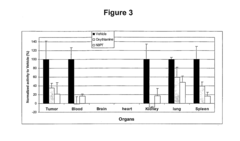Advances in Pentose Phosphate Pathway Insights for Drug Development
Pentose Phosphate Pathway for Drug Development: Research Background
The Pentose Phosphate Pathway (PPP) has been a subject of intense research in biochemistry and molecular biology for decades. This metabolic pathway, parallel to glycolysis, plays a crucial role in cellular metabolism, particularly in the production of NADPH and ribose-5-phosphate. The PPP's significance extends beyond basic cellular functions, as it has been increasingly recognized for its potential in drug development and therapeutic interventions.
Historically, the PPP was first described in the 1930s, with subsequent research elucidating its complex network of reactions and regulatory mechanisms. The pathway consists of two distinct phases: the oxidative phase, which generates NADPH, and the non-oxidative phase, which produces various sugar phosphates. These components are essential for numerous cellular processes, including nucleotide synthesis, lipid metabolism, and maintaining cellular redox balance.
Recent advances in molecular biology techniques and high-throughput screening methods have significantly enhanced our understanding of the PPP. Researchers have identified key enzymes and regulatory proteins that control the flux through this pathway, providing new targets for drug development. Moreover, the intricate connections between the PPP and other metabolic pathways have been revealed, highlighting its central role in cellular homeostasis.
The importance of the PPP in disease states has become increasingly apparent. Alterations in PPP activity have been implicated in various pathological conditions, including cancer, neurodegenerative disorders, and metabolic diseases. This realization has sparked renewed interest in targeting PPP components for therapeutic interventions. For instance, inhibitors of glucose-6-phosphate dehydrogenase, the rate-limiting enzyme of the oxidative phase, have shown promise in cancer treatment by disrupting the redox balance in tumor cells.
Furthermore, the PPP's role in cellular defense against oxidative stress has garnered attention in the context of aging and age-related diseases. The pathway's ability to generate NADPH, a crucial cofactor for antioxidant enzymes, positions it as a potential target for developing therapies aimed at mitigating oxidative damage and promoting cellular longevity.
As research in this field progresses, new technologies such as metabolomics and systems biology approaches are being employed to gain a more comprehensive understanding of the PPP's dynamics and interactions. These advancements are paving the way for innovative drug discovery strategies that leverage the pathway's central role in cellular metabolism.
Drug Market Demand Analysis
The global pharmaceutical market has shown a growing interest in drug development targeting the pentose phosphate pathway (PPP), driven by its crucial role in cellular metabolism and potential implications for various diseases. This pathway's significance in generating NADPH and ribose-5-phosphate has positioned it as a promising target for therapeutic interventions across multiple disease areas, including cancer, diabetes, and neurodegenerative disorders.
In the oncology sector, the demand for PPP-targeted drugs has been particularly robust. Cancer cells often exhibit an upregulated PPP to support their rapid proliferation and manage oxidative stress. This metabolic adaptation has created a substantial market opportunity for drugs that can selectively inhibit key enzymes in the pathway, such as glucose-6-phosphate dehydrogenase (G6PD) or transketolase. The potential for these drugs to synergize with existing chemotherapies or overcome drug resistance mechanisms has further amplified market interest.
The diabetes market has also shown significant demand for PPP-related drug development. The pathway's role in regulating glucose metabolism and its potential to influence insulin sensitivity has attracted attention from pharmaceutical companies seeking novel approaches to manage type 2 diabetes. Drugs targeting the non-oxidative branch of the PPP, which could modulate glucose utilization without increasing oxidative stress, are of particular interest to address the complex metabolic dysregulation in diabetic patients.
In the field of neurodegenerative diseases, the PPP's neuroprotective effects through NADPH production have sparked interest in drug development. The market demand in this area is driven by the growing prevalence of conditions such as Alzheimer's and Parkinson's disease, coupled with the limited efficacy of current treatments. Drugs that can enhance PPP activity in neurons or glial cells could potentially slow disease progression by improving cellular resilience against oxidative damage.
The rare disease market has also recognized the potential of PPP-targeted therapies. Genetic disorders affecting PPP enzymes, though individually rare, collectively represent a significant unmet medical need. The orphan drug designation and associated incentives have encouraged pharmaceutical companies to explore this niche market, potentially leading to high-value, specialized treatments.
Market analysis indicates a trend towards combination therapies involving PPP modulators. This approach aims to leverage the pathway's central role in metabolism to enhance the efficacy of existing drugs or overcome resistance mechanisms. The demand for such combination strategies is particularly strong in oncology and metabolic disorders, where multi-targeted approaches are increasingly favored.
The growing focus on personalized medicine has further shaped the market demand for PPP-related drugs. The pathway's variable activity across different patient populations and disease states has highlighted the need for companion diagnostics and biomarkers to identify patients most likely to benefit from PPP-targeted therapies. This trend is expected to drive the development of more precise and effective treatment strategies, potentially expanding the market for PPP-modulating drugs across various therapeutic areas.
Pentose Phosphate Pathway for Drug Development: Current Understanding
The pentose phosphate pathway (PPP) is a critical metabolic pathway that plays a crucial role in cellular metabolism and redox balance. Current understanding of the PPP has evolved significantly, providing valuable insights for drug development. The pathway consists of two distinct phases: the oxidative phase and the non-oxidative phase.
The oxidative phase of the PPP is responsible for generating NADPH, a crucial reducing agent for biosynthetic reactions and cellular defense against oxidative stress. This phase involves the conversion of glucose-6-phosphate to ribulose-5-phosphate through a series of enzymatic reactions. The key enzymes in this phase include glucose-6-phosphate dehydrogenase (G6PD), 6-phosphogluconolactonase, and 6-phosphogluconate dehydrogenase.
The non-oxidative phase of the PPP involves a series of reversible reactions that interconvert various sugar phosphates. This phase is essential for the production of ribose-5-phosphate, a precursor for nucleotide synthesis, and erythrose-4-phosphate, which is required for aromatic amino acid synthesis. The enzymes involved in this phase include transketolase, transaldolase, and ribulose-5-phosphate isomerase.
Recent advances in our understanding of the PPP have revealed its importance in cancer metabolism. Many cancer cells exhibit increased PPP activity, which provides them with a growth advantage by supplying NADPH for lipid biosynthesis and protection against oxidative stress. This insight has led to the exploration of PPP enzymes as potential targets for cancer therapy.
Furthermore, the PPP has been implicated in various other diseases, including neurodegenerative disorders, diabetes, and cardiovascular diseases. For instance, alterations in PPP activity have been observed in Alzheimer's and Parkinson's diseases, suggesting potential therapeutic opportunities in these areas.
The regulation of the PPP has also been a focus of recent research. Studies have shown that the pathway is tightly controlled by various factors, including substrate availability, product inhibition, and allosteric regulation. Understanding these regulatory mechanisms is crucial for developing effective therapeutic strategies targeting the PPP.
Advances in analytical techniques, such as metabolomics and flux analysis, have greatly enhanced our ability to study the PPP in detail. These methods allow for the quantification of metabolite levels and flux rates, providing a more comprehensive view of the pathway's dynamics in different physiological and pathological conditions.
Current PPP Drug Targets
01 Genetic engineering of the pentose phosphate pathway
Genetic modifications are made to enhance or alter the pentose phosphate pathway in microorganisms. This can involve introducing new genes, modifying existing ones, or altering regulatory elements to improve flux through the pathway. Such modifications can lead to increased production of desired metabolites or improved utilization of pentose sugars.- Metabolic engineering of the pentose phosphate pathway: This involves modifying the pentose phosphate pathway in microorganisms to enhance the production of valuable compounds. Techniques include overexpressing key enzymes, redirecting metabolic flux, and introducing heterologous genes to improve pathway efficiency and product yield.
- Utilization of pentose sugars in fermentation processes: Methods for improving the fermentation of pentose sugars, particularly from lignocellulosic biomass, by engineering microorganisms to efficiently metabolize these sugars through the pentose phosphate pathway. This can lead to enhanced production of biofuels and other valuable products.
- Regulation and manipulation of NADPH production: Strategies for controlling and enhancing NADPH production through the pentose phosphate pathway. This is crucial for various biotechnological applications, including the synthesis of pharmaceuticals, fine chemicals, and biofuels.
- Application in cancer metabolism and therapeutics: Exploration of the pentose phosphate pathway's role in cancer cell metabolism and the development of therapeutic strategies targeting this pathway. This includes identifying potential drug targets and biomarkers related to pathway dysregulation in cancer cells.
- Integration with other metabolic pathways: Studies on the interaction and integration of the pentose phosphate pathway with other metabolic pathways, such as glycolysis and the TCA cycle. This research aims to optimize overall cellular metabolism for various biotechnological applications and to understand complex metabolic disorders.
02 Metabolic engineering for improved pentose utilization
Strategies are developed to enhance the ability of microorganisms to utilize pentose sugars, particularly in the context of biofuel production. This can involve optimizing enzymes in the pentose phosphate pathway, introducing heterologous pathways, or modifying sugar transport systems to improve pentose uptake and metabolism.Expand Specific Solutions03 Regulation and control of the pentose phosphate pathway
Research focuses on understanding and manipulating the regulatory mechanisms of the pentose phosphate pathway. This includes studying transcriptional and post-translational regulation, metabolic flux analysis, and developing methods to control pathway activity for desired outcomes in biotechnology applications.Expand Specific Solutions04 Applications in metabolite production
The pentose phosphate pathway is exploited for the production of various valuable metabolites. This can include the synthesis of aromatic compounds, nucleotides, amino acids, or other industrially relevant molecules. Strategies may involve redirecting carbon flux through the pathway or coupling it with other metabolic pathways.Expand Specific Solutions05 Role in stress response and cellular redox balance
The pentose phosphate pathway's importance in maintaining cellular redox balance and responding to oxidative stress is investigated. This includes studying its role in producing NADPH, its involvement in antioxidant systems, and its potential as a target for improving cellular stress resistance in various organisms.Expand Specific Solutions
Key Players in pentose phosphate pathway Research
The competitive landscape for advances in Pentose Phosphate Pathway (PPP) insights for drug development is characterized by a diverse mix of players at various stages of research and development. The market is in a growth phase, with increasing interest from pharmaceutical companies, biotechnology firms, and academic institutions. While the market size is expanding, it remains relatively niche compared to broader drug development sectors. Technologically, the field is progressing rapidly, with companies like Bayer Pharma AG, Genentech, Inc., and AstraZeneca AB leading in research efforts. Academic institutions such as the University of California and Fudan University are contributing significant insights, while specialized biotech firms like Codexis, Inc. and AVEO Pharmaceuticals, Inc. are focusing on targeted applications of PPP in drug development.
Ajinomoto Co., Inc.
BASF SE
Pentose Phosphate Pathway Metabolic Innovations
- A fluorescence-based assay that measures the enzymatic activities of these enzymes in cell lysates, tissues, and blood, providing increased sensitivity and convenience by eliminating the need for enzyme isolation and reducing sample manipulation, allowing for high-throughput analysis.
- Genetic modification of Coryneform bacteria, such as Corynebacterium glutamicum, to overexpress enzymes of the pentose phosphate pathway, specifically transketolase, transaldolase, glucose-6-phosphate dehydrogenase, and 6-phosphogluconate-dehydrogenase, to enhance methionine production by increasing enzyme activity and copy numbers, thereby improving methionine synthesis efficiency.
Regulatory Considerations
The regulatory landscape surrounding drug development based on insights from the pentose phosphate pathway (PPP) is complex and multifaceted. Regulatory bodies, such as the FDA in the United States and the EMA in Europe, play crucial roles in overseeing the development and approval of drugs targeting this metabolic pathway.
One of the primary regulatory considerations is the demonstration of safety and efficacy. As the PPP is involved in various cellular processes, including the production of NADPH and ribose 5-phosphate, drugs targeting this pathway must undergo rigorous testing to ensure they do not disrupt essential metabolic functions. Regulatory agencies typically require extensive preclinical studies to assess the potential impact on glucose metabolism, oxidative stress response, and nucleotide synthesis.
Clinical trial design for PPP-targeted drugs presents unique challenges from a regulatory perspective. The interconnected nature of metabolic pathways necessitates careful consideration of potential off-target effects. Regulatory bodies often require comprehensive pharmacokinetic and pharmacodynamic studies to elucidate the drug's mechanism of action and its broader metabolic impact.
Another key regulatory aspect is the development of appropriate biomarkers for PPP-targeted therapies. Regulatory agencies encourage the identification and validation of biomarkers that can accurately measure the drug's effect on the pathway. This may include markers of NADPH levels, oxidative stress, or specific enzyme activities within the PPP.
The regulatory framework also emphasizes the importance of patient selection and stratification in clinical trials. Given the potential variability in PPP activity across different patient populations, regulatory bodies may require sponsors to demonstrate the drug's efficacy in specific subgroups or to provide a clear rationale for the target patient population.
Intellectual property considerations are another critical regulatory aspect. As research into the PPP for drug development advances, patent protection and exclusivity periods become increasingly important. Regulatory agencies work in conjunction with patent offices to ensure fair market competition while incentivizing innovation in this emerging field.
Lastly, post-market surveillance requirements for PPP-targeted drugs may be more stringent due to the pathway's fundamental role in cellular metabolism. Regulatory bodies may mandate long-term safety monitoring and additional studies to assess the drug's impact on metabolic health over extended periods.
Metabolomics Integration
The integration of metabolomics into pentose phosphate pathway (PPP) research has significantly enhanced our understanding of this crucial metabolic pathway and its potential for drug development. Metabolomics, the comprehensive study of small molecule metabolites in biological systems, provides a powerful tool for elucidating the complex interactions and regulatory mechanisms within the PPP.
By employing advanced analytical techniques such as mass spectrometry and nuclear magnetic resonance spectroscopy, researchers can now obtain detailed metabolic profiles of cells and tissues. This high-resolution data allows for the identification and quantification of key PPP intermediates and products, offering unprecedented insights into the pathway's dynamics and regulation.
The application of metabolomics has revealed novel connections between the PPP and other metabolic pathways, highlighting its central role in cellular metabolism. For instance, recent studies have uncovered intricate links between the PPP and glutamine metabolism, shedding light on how cancer cells adapt their metabolism to support rapid proliferation.
Furthermore, metabolomics has enabled the discovery of previously unknown metabolites and regulatory mechanisms within the PPP. These findings have expanded our understanding of the pathway's flexibility and adaptability in response to various cellular stresses and environmental conditions.
In the context of drug development, metabolomics integration has proven invaluable for identifying potential therapeutic targets within the PPP. By mapping the metabolic changes induced by genetic or pharmacological perturbations, researchers can pinpoint critical nodes in the pathway that may be susceptible to therapeutic intervention.
Moreover, metabolomics approaches have facilitated the development of biomarkers for PPP activity, which can be used to monitor drug efficacy and predict treatment outcomes. This has particular relevance in cancer therapy, where alterations in PPP activity are often associated with drug resistance and disease progression.
The integration of metabolomics with other omics technologies, such as genomics and proteomics, has further enhanced our ability to decipher the complex regulatory networks governing the PPP. This multi-omics approach provides a more comprehensive view of cellular metabolism, enabling the identification of novel drug targets and the development of more effective therapeutic strategies.
As metabolomics technologies continue to advance, their integration into PPP research is expected to yield even more profound insights. Emerging techniques, such as single-cell metabolomics and in vivo metabolic imaging, promise to provide unprecedented spatial and temporal resolution of PPP activity, further refining our understanding of this critical pathway and its potential for therapeutic manipulation.



